Teaching large classes focus of technology grants to two faculty
June 23, 2010

Sara Corwin
 Mindi Spencer
Mindi Spencer
Two Arnold School of Public Health faculty members are part of a university-wide effort to use technology to facilitate discussion and better learning outcomes in large classrooms.
Dr. Cheryl Addy, senior associate dean for academic affairs, said Dr. Sara Corwin and Dr. Mindi Spencer are recipients of $3,600 mini grants through the university’s Center for Teaching Excellence.
Spencer’s class is HPEB 511: “Health Problems in a Changing Society.” Corwin teaches PUBH 102: “Introduction to Public Health.” Both are traditional courses required for most public health students.
“The issue of teaching larger classes is not going away,” said Dr. Jed Lyons, a mechanical engineering professor and faculty director of the Center for Teacher Excellence.
“The purpose of these grants is to go beyond solving individual problems with teaching large classes and develop a model of expertise that will help everyone in the University community.”
The classes that Corwin and Spencer teach are actually not that large, Addy said, but the hope is the two will help develop protocols and recommendations that they can share with other Arnold faculty as the school’s enrollment continues to climb.
“As our undergraduate enrollment grows, we anticipate more large classes. And while technology can be used in any size classroom, the need for and utility of technology is probably more critical in larger classes,” Addy said.
Exercise Science, with six classes of more than 100 students, currently is the department that may benefit most from the project, Addy said.
“I can identify at least six classes that typically have enrollments over 100: EXSC 191, 223 and 224, 351, and 530 and 531. The two pairs of courses are sequenced anatomy and physiology courses. Fortunately, the large lecture classes are augmented by much smaller lab sections, so that students have more contact with teachers,” she said.
Currently, the school’s infrastructure for classroom technology is extremely limited. The quality of the facilities ranges from good -- a mounted projector with permanent VCR/DVD player and control panel in the PHRC auditorium and seminar rooms -- to adequate -- where the instructor literally transports a computer and a projector to the classroom, she said.
One of Spencer’s goals for the fall session of the HPEB 511 course is to preserve “what I feel is the greatest strength of the course – our in-depth discussions about current issues related to public health in the United States.”
The fall semester class is divided into two sessions. Spencer will teach one and a graduate student, working in close collaboration, will teach a mirror session. Spencer’s plan is to try to think of the two sessions a one large “virtual class,” using Blackboard technology to create smaller, more manageable online discussion groups.
“I would also like to improve the relevance of the course by identifying online resources that the students can access to learn about the most current policy initiatives in public health that are being considered on Capitol Hill,” she said.
Spencer wants to become thoroughly expert in the use of Blackboard by the fall so that she will be able to embed public health resources in the technology and enhance the relevance of the material to the course.
Corwin will use polling software, which students can access through any Web-enabled device such as an Iphone, Blackberry, IPad, or computer notebook.
“I can propose questions during lectures via PowerPoint, and the students can register a reply using their Web device,” said Corwin, who likened the application to the game show “Who Wants to Be a Millionaire?” in which the audience can be polled to give an answer to a contestant.
“I know immediately if the students are paying attention, are engaged, or understand and comprehend my lecture,” she said.
The ability for students to have anonymity in their responses is an appealing feature, Corwin said.
“Many of the subjects that we discuss in public health can be sensitive or potentially controversial,” she said. “It’s important that we provide a safe place for all opinions to be heard.”
Corwin is testing QREC, developed by University of South Carolina theoretical physicist Dr. Joseph Johnson, whose company Advanced Solutions Group (ASG) is renowned for its advances in technology development.
“I’m interested in using interactive technology to engage students in the classroom and to enhance the learning process,” Corwin said. “This technology that Dr. Johnson has developed is incredible, and his willingness to let us test it is quite generous. I look forward to sharing this information with my colleagues this fall and getting the feedback from students.”



_01.jpg)
_02.jpg)